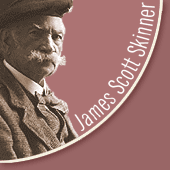




Please click any thumbnail image to view the full details.
There are 900 entries.
prev 10 | 44 > 45 > 46 > 47 > 48 > 49 > 50 > 51 > 52 > 53 | next 10 of 90 pages
| Image | Title | Item Description |
|---|---|---|
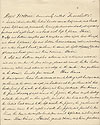 JSS0493 |
Royal Victoria, or Marshall's | This excerpt is from a series of notebooks compiled by Skinner and his own dance teacher, William Scott. The notebooks were published under the title, A Guide to Fashionable Dancing. Royal Victoria. Commonly called 'Marshall's'. 1. Ladies' chain, double; hands across half round, and back again to places; all promenade, turning partners at each side, all eight swing partners with right hand and back with left to places. Twice. 2. Top and bottom couples set to couples on their right, lead through, and back to places; top and bottom ladies advance, retire, and advance and retire back to back; gentlemen the same; also eight chassez to partners places and back again and turn corners. Twice. 3. Top and bottom couples advance and retire, and advance and set in centre: the four change places all round; the two ladies advance, retire, and advance and stop in the centre; two gentlemen do the same; hands four round. Four times. 4. Grand square; ladies' hands across, all round, holding right hand up in centre; gentlemen do the same; all eight join hands and set, the gentlemen with their backs facing the inside of the figure, and turn partners. Four times. 5. Grand chassez of eight round the figure, the first couple leading outside the couple on their right; finish in two lines, and turn partners, the ladies lead round to the left inside the figure, the gentlemen at the same time to the right outside the figure, and finish in two lines, the two centre couples hands four round to places, and turn partners. Four times. Finish, grand chain, and turn partners. |
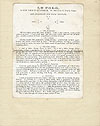 JSS0494 |
Le Polo | This excerpt is from a series of notebooks compiled by Skinner and his own dance teacher, William Scott. The notebooks were published under the title, A Guide to Fashionable Dancing. This version of Le Polo, 'a new French Quadrille', has been pasted into the notebook by the compilers. A diagram at the top shows where the dancers should stand. In common with other quadrilles, it has five figures. |
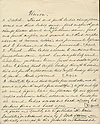 JSS0495 |
Page 1 of 2, Union Quadrilles | This excerpt is from a series of notebooks compiled by Skinner and his own dance teacher, William Scott. The notebooks were published under the title, A Guide to Fashionable Dancing. Each figure has a 'nationality'. Union. 1. Scotch. First and fourth ladies change places - second and third ladies same - first and fourth gents change places - second and third gentlemen same - first and fourth couples, and second and third couples advance at corners, retire and promenade to places. Set to partners - and turn - promenade - [Repeat. 2. French - Four ladies advance to centre and turn - four gentlemen same - repeat - hands eight half round - ladies turn - gentlemen turn - first and second couples return to places, first couple leading through the second - third and fourth couples same, third couple leading through the fourth - Hands eight round. [Repeat. 3. Irish [The top and third couples face eachother, and the second and fourth couples face each other.] Right and left all round figure, till in your places - top and opposite couples advance - retire - advance - and hands four all round - ladies across and back - chassez into partners places and back again. [Repeat. [Note:] In press and speedily will be published 'The Union Quadrilles', on National Airs, by J. Scott Skinner specially arranged for this favourite and unknown [replaced with] neglected set. [Continued at JSS0496]. |
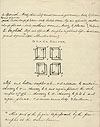 JSS0496 |
Page 2 of 2, Union Quadrilles | This excerpt is from a series of notebooks compiled by Skinner and his own dance teacher, William Scott. The notebooks were published under the title, A Guide to Fashionable Dancing. [continued from JSS0495]. 4. Spanish - Waltz chain half round (commencing at corners) - Waltz to places - top and opposite ladies change places - side ladies same - top and opposite gentlemen change places - side gentlemen same - Waltz to places {Repeat. 5. English. Top and oppposite couples right and left - ladies chain, grand square* (see illustration.) [Immediately under this is a diagram of the Grand Square, which illustrates where each couple should place themselves whilst performing the Grand Square formation.] Top and bottom couples ab - cd advance to centre i - chassez to i. - chassez to s, and regain places; the side couples efgh - chassez to o - chassez to p to i and again to places. o at corners means lady, [diamond shape] means Gentlemen. *[Note:] This part of the figure [the Grand Square] is performed by the four couples at the same time. |
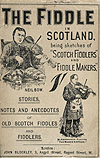 JSS0497 |
The Fiddle in Scotland, being sketches of 'Scotch Fiddlers' and 'Fiddle Makers', page 1 of 4 | Title page of The Fiddle in Scotland, by Alexander Murdoch, father of fiddler William Mackenzie Murdoch, who styled himself on Skinner. The drawing of Niel Gow is taken from Henry Raeburn's painting in the Scottish National Portrait Gallery, Edinburgh. Duncan McKerracher, illustrated at the bottom of the page, was famous for performing the reel The Mason's Apron while wearing, as he does here, a Freemason's apron and sash. |
 JSS0498 |
Willie Blair. 'The Queen's Fiddler', p 1 of 3 | Page 1 of 3 of Alexander Murdoch's (see JSS0497) essay on Willie Blair, fiddler to Queen Victoria (see JSS0038). Blair (1794-1884) was born in Crathie, near what would become Balmoral Castle, the Highland retreat of the Queen and Prince Albert. Taught by his father, Blair was known for the 'enthusiasm' and 'force' of his playing, always keeping time with his right foot ('chappin' wi' my richt fit'). |
 JSS0499 |
Willie Blair. 'The Queen's Fiddler', p 2of 3 | Page 2 of 3 of an essay on Willie Blair, fiddler to Queen Victoria at Balmoral. |
 JSS0500 |
Willie Blair. 'The Queen's Fiddler', p 3 of 3 | Page 3 of 3 of Alexander Murdoch's (see JSS0497, JSS0498, JSS0499) essay on Willie Blair, fiddler to Queen Victoria at Balmoral Castle (see JSS0038). Willie was not a great fiddler, but was true to himself. He used the 'Doric', the North-east Scots tongue, took snuff, and had a good sense of humour. The Queen visited his cottlage, and, although not mentioned here, arranged for some of his compositions to be published after his death. |
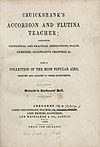 JSS0501 |
Title Page, Cruickshank's Accordion and Flutina Teacher, page 1 of 4 | Title page, page 1 of 4, Cruickshank's Accordion and Flutina Teacher. The accordion is now commonly used in Scottish dance music. This Aberdeen instruction manual was published in 1852, to appeal to those with the Victorian belief in self-improvement. The tutor supplied 'Theoretical and Practical Instructions, Scales, Exercies, Illustrative Drawings, &c. with a Collection of the Most Popular Airs....' |
 JSS0502 |
Cruickshank's Accordion and Flutina Teacher, page 2 of 4 | Page 2 of 4, Cruickshank's Accordion and Flutina Teacher. Diagram demonstrating how to hold the instrument. This accordion is much simpler and smaller than modern instruments. The players' fingers operated a series of key-like levers to play the notes. |
prev 10 | 44 > 45 > 46 > 47 > 48 > 49 > 50 > 51 > 52 > 53 | next 10 of 90 pages
